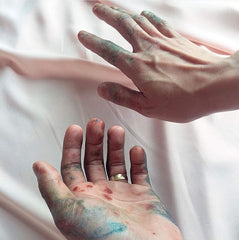- No products in the cart.
Opulent fabrics are used to create delicate pieces in our collections. With a smooth surface and tight weave, silk makes the perfect fabric for absorbing the medley of colours during the dyeing process. Marbling has origins deep set in the days of the T’ang dynasty of China, spreading widely to India, Iran, Turkey & finally Europe via the Silk Road.
 The most widely held belief is that marbling originated in Japan as an art form called suminagashi which translates to 'ink floating', this technique focused on floating blank inks on water to create patterns on paper. The beautiful patterns caught on quickly with people and spread to China during the T'ang dynasty whereby ceramic were made using a sort of marbling technique.
The most widely held belief is that marbling originated in Japan as an art form called suminagashi which translates to 'ink floating', this technique focused on floating blank inks on water to create patterns on paper. The beautiful patterns caught on quickly with people and spread to China during the T'ang dynasty whereby ceramic were made using a sort of marbling technique.
The technique very quickly spread across the silk road and by the 15th century, the art form had made it's way through India, across Iran and the middle east and into Turkey.
In Turkey, the technique was used to verify the authenticity of official documents during the time of the Turkish Empire / Persian Empire. The Turkish were likely the first to have used thickening solutions to make the water more jelly like and similar to widely used marbling solutions today. They would then comb intricate patterns through the marbling which were simply stunning, this art they called Ebru or 'cloud art'. Once there it spread over to Europe via Italy and the European countries quickly came up with their own unique techniques such as the 'old Dutch' and the 'French curl'.
They are many accounts in history that tells us that, upon reaching Europe, the secrets of marbling were very closely guarded by the merchants who brought them via the silk road and so they would only teach artisans one step of the process each, so that nobody could copy it for themselves. There are even accounts of artisans working behind wooden partitions so that they were not able to see any of the rest of the process once they had completed their step and so that others could not see them.
There is evidence too, that by the 17th century, marbling was widely used to create opulent and colourful bookends in the homes of affluent families to create unique decor.
Historically, marble dyeing has been exclusive to paper. With the growing interest in marbling on fabric, Edward Mongzar has successfully brought the mediums of marbling and luxury fashion to life, with marble dyeing on luxury fabrics.
Using this centuries old Artisanal craft, Edward attempts to capture the subtle nuances and natural flow of the colour swirling on the water; impressing upon the fabric a serene colour effect. The resulting patterns are as free and gentle as the paint on the water. Edward views the marbling process as a representation of the ideal 'live and let live', with the water and dye acting independently but coming together to create something beautiful.
When marbling, Edward gently drips dye onto the surface of the water in the marbling tank, taking care to ensure he allows enough time for the dye to spread across the water, capturing every subtle swirl. Then, he take the fabric and lays it flat atop the water's surface so that the fabric soaks in the patterns.
He then dries the fabric in the natural heat of the sun, avoiding any un-necessary use of electricity during the drying process and allowing mother nature to work her magic on the silk. After the dry, they are washed gently to ensure no run off colour and are then ready to be made into the ethereal silk pieces that Edward Mongzar is so well known for!
Due to the unique nature of the patterns caused by the dye swirling atop the water, each pieces is completely unique as no two prints will ever be the same.



